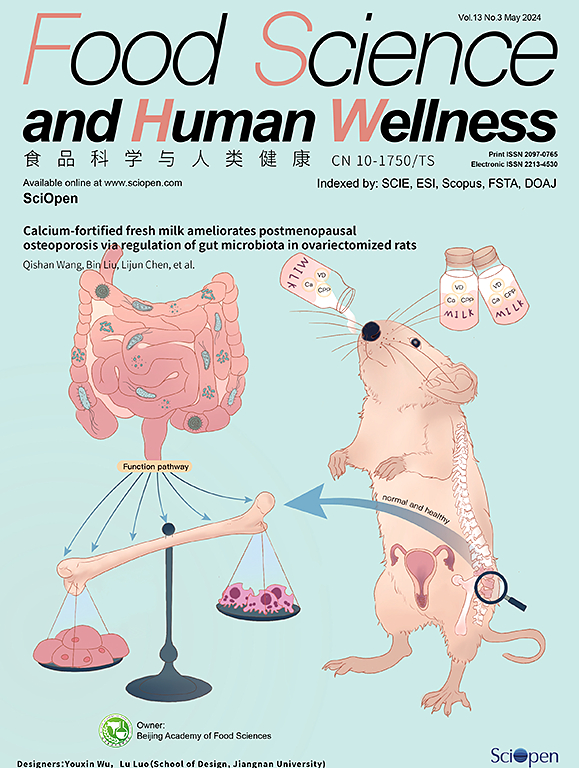Antiglycating effects of citrus flavonoids and associated mechanisms
IF 7.4
1区 农林科学
Q1 FOOD SCIENCE & TECHNOLOGY
引用次数: 0
Abstract
Glycation of proteins and DNA forms advanced glycation end products (AGEs) causing cell and tissue dysfunction and subsequent various chronic diseases, in particular, metabolic and age-related diseases. Targeted AGE inhibition includes scavengers of reactive carbonyl species (RCS) such as methylglyoxal (MG), glyoxalase-1 enhancers, Nrf2/ARE pathway activators, AGE/RAGE formation inhibitors and other antiglycatng agents. Citrus flavonoids have demonstrated antioxidant and anti-inflammatory effects and are also found to be effective antiglycating agents. Herein, we reviewed the up to date progress of the antiglycation effects of citrus flavonoids and associated mechanisms. Major citrus flavonoids, hesperedin and its aglycone, hesperetin, inhibited glycation by scavenging MG forming mono- or di-flavonoid adducts with MG, enhanced the activity of glyoxase-1, activated Akt/Nrf2 signal pathway while inhibiting AGE/RAGE/NF-κB pathway, reduced the formation of Nε-(carboxylmethyl)lysine (CML) and pentosidine, inhibited aldol reductase activity and decreased the levels of fructosamine. The antiglycating activity and mechanisms of other flavonoids was also summarized in this review. In conclusion, citrus flavonoids possess effective antiglycating activity via different mechanisms, yet there are many challenging questions remaining to be studied in the near future such as in vivo testing and human study of citrus flavonoids for efficacy, effectiveness and adverse effects of citrus flavonoids as a functional food in managing high levels of AGEs and controlling AGE-induced chronic diseases, diabetic complications in particular.
柑橘类黄酮的抗糖化作用及相关机制
蛋白质和 DNA 的糖化会形成高级糖化终产物(AGEs),导致细胞和组织功能障碍,进而引发各种慢性疾病,尤其是代谢性疾病和与年龄有关的疾病。有针对性的 AGE 抑制剂包括甲基乙二醛(MG)等活性羰基(RCS)清除剂、乙醛缩醛酶-1 增强剂、Nrf2/ARE 途径激活剂、AGE/RAGE 形成抑制剂和其他抗糖化剂。柑橘类黄酮具有抗氧化和抗炎作用,也是有效的抗糖化剂。在此,我们回顾了柑橘类黄酮抗糖化作用及相关机制的最新进展。主要的柑橘类黄酮、橙皮素及其苷元橙皮素通过清除与 MG 形成单或双黄酮加合物的 MG 来抑制糖化,增强糖化酶-1 的活性、激活 Akt/Nrf2 信号通路,同时抑制 AGE/RAGE/NF-κB 通路,减少 Nε-(羧甲基)赖氨酸(CML)和喷托糖苷的形成,抑制醛醇还原酶的活性,降低果糖胺的水平。本综述还总结了其他黄酮类化合物的抗糖化活性和机制。总之,柑橘类黄酮通过不同的机制具有有效的抗糖化活性,但在不久的将来仍有许多具有挑战性的问题有待研究,如柑橘类黄酮的体内试验和人体研究,以了解柑橘类黄酮作为功能食品在控制高浓度 AGEs 和控制 AGE 引起的慢性疾病(尤其是糖尿病并发症)方面的功效、有效性和不良影响。
本文章由计算机程序翻译,如有差异,请以英文原文为准。
求助全文
约1分钟内获得全文
求助全文
来源期刊

Food Science and Human Wellness
Agricultural and Biological Sciences-Food Science
CiteScore
8.30
自引率
5.70%
发文量
80
审稿时长
28 days
期刊介绍:
Food Science and Human Wellness is an international peer-reviewed journal that provides a forum for the dissemination of the latest scientific results in food science, nutriology, immunology and cross-field research. Articles must present information that is novel, has high impact and interest, and is of high scientific quality. By their effort, it has been developed to promote the public awareness on diet, advocate healthy diet, reduce the harm caused by unreasonable dietary habit, and directs healthy food development for food industrial producers.
 求助内容:
求助内容: 应助结果提醒方式:
应助结果提醒方式:


